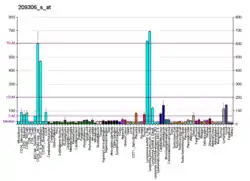SWAP70
Switch-associated protein 70 is a protein that in humans and other mammals is encoded by the SWAP70 gene.[5][6][7][8]
References
- GRCh38: Ensembl release 89: ENSG00000133789 - Ensembl, May 2017
- GRCm38: Ensembl release 89: ENSMUSG00000031015 - Ensembl, May 2017
- "Human PubMed Reference:". National Center for Biotechnology Information, U.S. National Library of Medicine.
- "Mouse PubMed Reference:". National Center for Biotechnology Information, U.S. National Library of Medicine.
- Ishikawa K, Nagase T, Suyama M, Miyajima N, Tanaka A, Kotani H, Nomura N, Ohara O (Dec 1998). "Prediction of the coding sequences of unidentified human genes. X. The complete sequences of 100 new cDNA clones from brain which can code for large proteins in vitro". DNA Res. 5 (3): 169–76. doi:10.1093/dnares/5.3.169. PMID 9734811.
- Masat L, Caldwell J, Armstrong R, Khoshnevisan H, Jessberger R, Herndier B, Wabl M, Ferrick D (Apr 2000). "Association of SWAP-70 with the B cell antigen receptor complex". Proc Natl Acad Sci U S A. 97 (5): 2180–4. Bibcode:2000PNAS...97.2180M. doi:10.1073/pnas.040374497. PMC 15774. PMID 10681448.
- "Entrez Gene: SWAP70 SWAP-70 protein".
- Pearce G, Angeli V, Randolph GJ, Junt T, von Andrian U, Schnittler HJ, Jessberger R (August 2006). "Signaling protein SWAP-70 is required for efficient B cell homing to lymphoid organs". Nat. Immunol. 7 (8): 827–34. doi:10.1038/ni1365. PMID 16845395. S2CID 30891179.
Further reading
- Borggrefe T, Wabl M, Akhmedov AT, Jessberger R (1998). "A B-cell-specific DNA recombination complex". J. Biol. Chem. 273 (27): 17025–35. doi:10.1074/jbc.273.27.17025. PMID 9642267.
- Rapalus L, Minegishi Y, Lavoie A, et al. (2002). "Analysis of SWAP-70 as a candidate gene for non-X-linked hyper IgM syndrome and common variable immunodeficiency". Clin. Immunol. 101 (3): 270–5. doi:10.1006/clim.2001.5116. PMID 11726218.
- Nakayama M, Kikuno R, Ohara O (2003). "Protein-protein interactions between large proteins: two-hybrid screening using a functionally classified library composed of long cDNAs". Genome Res. 12 (11): 1773–84. doi:10.1101/gr.406902. PMC 187542. PMID 12421765.
- Strausberg RL, Feingold EA, Grouse LH, et al. (2003). "Generation and initial analysis of more than 15,000 full-length human and mouse cDNA sequences". Proc. Natl. Acad. Sci. U.S.A. 99 (26): 16899–903. Bibcode:2002PNAS...9916899M. doi:10.1073/pnas.242603899. PMC 139241. PMID 12477932.
- Hilpelä P, Oberbanscheidt P, Hahne P, et al. (2004). "SWAP-70 identifies a transitional subset of actin filaments in motile cells". Mol. Biol. Cell. 14 (8): 3242–53. doi:10.1091/mbc.E03-01-0043. PMC 181564. PMID 12925760.
- Ota T, Suzuki Y, Nishikawa T, et al. (2004). "Complete sequencing and characterization of 21,243 full-length human cDNAs". Nat. Genet. 36 (1): 40–5. doi:10.1038/ng1285. PMID 14702039.
- Gerhard DS, Wagner L, Feingold EA, et al. (2004). "The status, quality, and expansion of the NIH full-length cDNA project: the Mammalian Gene Collection (MGC)". Genome Res. 14 (10B): 2121–7. doi:10.1101/gr.2596504. PMC 528928. PMID 15489334.
- Rual JF, Venkatesan K, Hao T, et al. (2005). "Towards a proteome-scale map of the human protein-protein interaction network". Nature. 437 (7062): 1173–8. Bibcode:2005Natur.437.1173R. doi:10.1038/nature04209. PMID 16189514. S2CID 4427026.
- Kimura K, Wakamatsu A, Suzuki Y, et al. (2006). "Diversification of transcriptional modulation: large-scale identification and characterization of putative alternative promoters of human genes". Genome Res. 16 (1): 55–65. doi:10.1101/gr.4039406. PMC 1356129. PMID 16344560.
- Ihara S, Oka T, Fukui Y (2006). "Direct binding of SWAP-70 to non-muscle actin is required for membrane ruffling". J. Cell Sci. 119 (Pt 3): 500–7. doi:10.1242/jcs.02767. PMID 16418221.
- Kimbara N, Dohi N, Miyamoto M, et al. (2006). "Diagnostic surface expression of SWAP-70 on HIV-1 infected T cells". Microbiol. Immunol. 50 (3): 235–42. doi:10.1111/j.1348-0421.2006.tb03790.x. PMID 16547421. S2CID 85037572.
- Liu J, Li D, Cao B, et al. (2007). "Expression and localization of SWAP-70 in human fetomaternal interface and placenta during tubal pregnancy and normal placentation". J. Histochem. Cytochem. 55 (7): 701–8. doi:10.1369/jhc.6A7151.2007. PMID 17371938.
This article is issued from Wikipedia. The text is licensed under Creative Commons - Attribution - Sharealike. Additional terms may apply for the media files.







